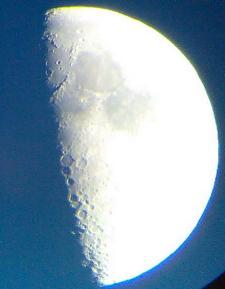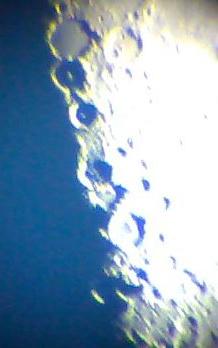2006-05-05
| Location: | Billingborough (South Lincolnshire, UK) |
| From: | 2006-05-05 12:50 UT |
| To: | 2006-05-05 12:54 UT |
| Equipment: |
Solarscope
|
| Temperature: | 22.8°C ... |
| Dew Point: | 8.8°C ... |
| Humidity: | 41% ... |
| Wind Speed: | 7mph ... |
| Wind Dir: | South South West ... |
| Pressure: | 1018.2hPa ... |
| Notes: |
Mostly clear, just a few clouds about, slight breeze. Nice and warm. Did a quick sunspot count with the Solarscope. |
Sun
| From: | 2006-05-05 12:50 UT |
| To: | 2006-05-05 12:54 UT |
|
With the Solarscope I could only see two active areas (as best as I can tell they were 878 and 880). Could only see a single spot in each area giving a total of two spots for today. |
| Location: | Billingborough (South Lincolnshire, UK) |
| From: | 2006-05-05 19:34 UT |
| To: | 2006-05-05 21:45 UT |
| Equipment: |
Meade 10x50 Binoculars
Antares 905 |
| Temperature: | 18.3°C ... |
| Dew Point: | 8.2°C ... |
| Humidity: | 52% ... |
| Wind Speed: | Calm ... |
| Pressure: | 1019.1hPa ... |
| Notes: |
A clear, warm and calm evening. The sky was still very light (the Sun hadn't long set). I decided to set up the 905 to have a session observing the Moon (which was just past first ¼). I also intended to observe Saturn and, if I was out late enough and the position was right, Jupiter. All being well I also wanted to try and further observe 73P Schwassmann-Wachmann 3 although I didn't hold out too much hope given how bright the Moon was going to be. |
Searching for Saturn in a light sky
| From: | 2006-05-05 19:34 UT |
| To: | 2006-05-05 19:41 UT |
|
Although the sky was still very light I did a quick sweep of the area to the west of the Moon with the binoculars to see if I could spot Saturn. Pretty quick I spotted it. Having found it with the binoculars I tried to get it in the 905 but, even using the 32mm eyepiece to give me a fighting chance, I just couldn't track it down. I guess, if I'd persisted, I'd have got it in the end but I decided to give up and move on to the Moon. |
Imaging the Moon with a mobile phone
| From: | 2006-05-05 19:51 UT |
| To: | 2006-05-05 19:55 UT |
|
I lined the Moon up in the 905 and, because I had my mobile phone in my pocket, I decided to try taking some shots. I knew they weren't going to be anything clever but I thought I'd have a try anyway. All attempts were using afocal projection while simply holding the phone in my hand. I took a number of images but most of them were really terrible and were deleted on the spot. The following were the best of the bunch (which gives a good idea of how terrible the others were).
|
The Moon
| From: | 2006-05-05 20:14 UT |
| To: | 2006-05-05 21:00 UT |
|
After taking the images shown above, and after a short break from "proper" observing to show my wife the Moon via the 905, I stayed with the Moon to work my way along parts of the terminator and areas close to it. The first features that really stood out were Ptolemaeus, Alphonsus and Arzachel. While Ptolemaeus was mostly fully lit by the sunlight (the floor looking very smooth except for a couple of small but obvious craters within it) Alphonsus and Arzachel both had their floors in shadow but with their central peaks lit. Further south I could see (running east to west) Nasireddin, Huggins and Orontius. The latter was mostly in shade, in the night side of the terminator, but the "back" wall (in relation to the direction of the sunlight) was fully lit. I could also very clearly see a small crater in the wall (which is unnamed on the map I had with me). To the north, on the eastern side of Mare Imbrium, I could clearly see Mons Piton casting a very long shadow which seemed to have a conical shape about it. Over in the night side I could clearly see the peak of Mons Pico. Near it, just to the south, I could see another sunlit peak. The mountain in question is on my map but isn't named (I can see I'm going to have to get a more detailed map of the Moon some time soon). The next thing I saw, clearly cutting a path through Montes Alpes, was Vallis Alpes. Although I've seen plenty of images of this feature I was still quite taken by how striking it was. This is a good candidate for further observations and possibly a good candidate for a lunar sketch at some point in the future. The shadows from Montes Alpes were very striking — I counted 6 distinct shadows stretching out into the floor of Mare Imbrium. One of them appeared much longer than the others and I took this to be the shadow of Mons Blanc. Other mountain ranges that stood out were Montes Spitzbergen (which could be seen just north of Archimedes and more or less on the terminator) and Montes Archimedes (which was also more or less on the terminator, south of Archimedes). The next thing I noticed, in the terminator, was the eastern wall of Plato. Above it, in Mare Frigoris, I then noticed what looked like some sort of ridge running more or less east to west. I could see a hint of the feature on my map but no name is given. While the impression on the map is that it isn't a very distinct feature the view I had was one of a feature that was very significant (not very surprising really given its proximity to the terminator — the western end of it seemed to disappear into the terminator). To some degree the view I had reminded me of Rupes Recta, except this feature more or less runs east/west (unlike Rupes Recta, which runs more or less north/south). The "higher" side (the side that appeared to be sunlit) was the north side — the south side seeming to be in shadow. At 20:52 UT the seeing suddenly deteriorated and for the first time this session there seemed to be a breeze about. Given that the image in the 'scope seemed to be getting worse I finally decided, at 21:00 UT, that it would be a good time to take a short break. |
Assessing the viewing conditions
| Time: | 2006-05-05 21:10 UT |
|
By now the sky had got quite dark but the moonlight was visibly causing problems — making the sky look quite washed out. Conditions were so bad that I couldn't actually make out the Keystone. Conditions didn't look good for viewing the comet. Although it was hard to tell at this point there was a hint of some cloud moving in on the eastern horizon. |
Brief look at Saturn
| From: | 2006-05-05 21:15 UT |
| To: | 2006-05-05 21:25 UT |
|
Had a brief look at Saturn with the 905 and the 6mm eyepiece. It wasn't anywhere near the best view I've had of it this apparition but I was still able to make out both of the shadows, a hint of handing on the planet's surface and, from time to time, the Cassini Division would pop in and out of view. |
A quick hunt for Comet Schwassmann-Wachmann 3
| From: | 2006-05-05 21:20 UT |
| To: | 2006-05-05 21:30 UT |
|
Used the binoculars quickly hunt for fragments B or C of 73P Schwassmann-Wachmann 3 but failed to find them. I did note that M13 was only just visible so it didn't come as any surprise that I failed. |
Assessing the chances of observing Jupiter
| From: | 2006-05-05 21:33 UT |
| To: | 2006-05-05 21:34 UT |
|
Wandered around the house looking for a possible vantage point that would give me a good view of Jupiter but couldn't find a location that would give a clear view with the 905. I did have a quick look with the binoculars and could briefly see a hint of the Jovian moons but the eyepieces misted up and put a stop to that. |
Increasing cloud — end of session
| From: | 2006-05-05 21:35 UT |
| To: | 2006-05-05 21:45 UT |
|
Just after checking on Jupiter I noticed that it was starting to fade and, shortly after that, it totally disappeared. I quickly became obvious that a bank of cloud was moving in from the east. Within a couple of minutes it was almost overhead and I could see no stars all the way down to the eastern horizon. Because it looked like there wasn't going to be a break in this (and the forecasts for the evening had it clouding up with a chance of rain) I called an end to the session. |

